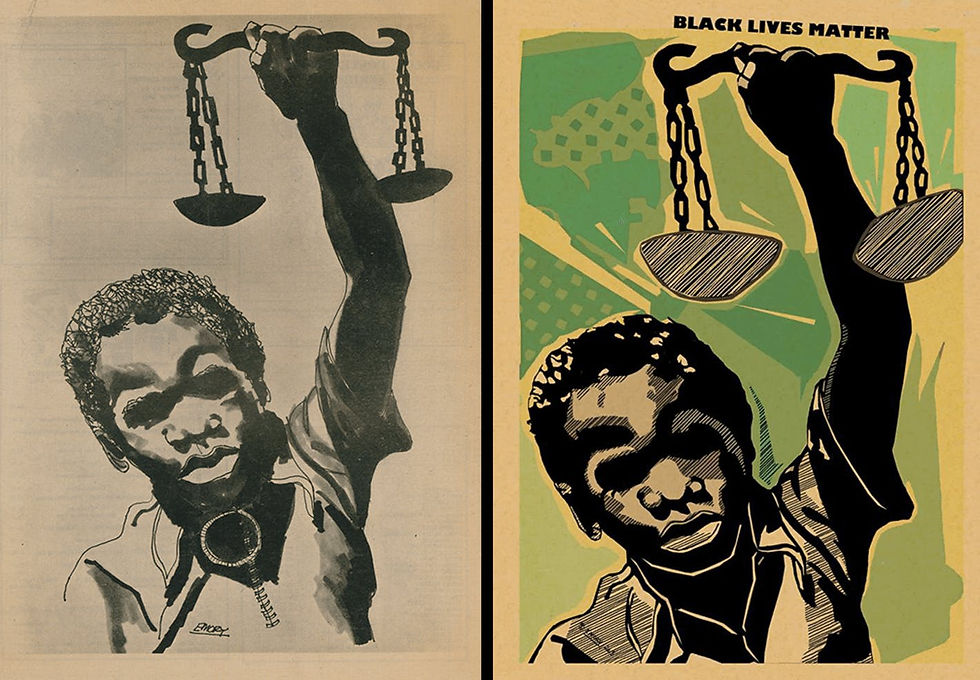Download the entire module here:
Here’s a glimpse into Part I of the resource:
Introduction
Writing in 1873, anti-caste social reformer Jyoti Rao Phule in his Gulamgiri, talks about the ties of suffering that bind the Shudras with the African slaves in America. In 1965, novelist John O. Killens wrote in Black Man’s Burden, ‘Please do not give us the example of India and Mohandas Karamchand Gandhi….The situations are not similar; they could not be more dissimilar.’ Yet, nearly a century after Phule’s work was published, the Dalit Panther Party was born, inspired by and formally aligning itself with the Black Panther Party. Political theorist Kancha Ilaiah Shepherd expounds this tie when he writes,
‘Similar to how the Whites subjugated Blacks based on notions of superiority for free or cheap labour, the so-called upper castes in India exploited the Shudras and Dalits by holding themselves as superior to achieve and sustain dominance in the hierarchical construct of the Hindu society. Moreover, just like the current generation of White Americans and Europeans are not responsible for slave trade and colonialism but reaping their benefits, the ‘twice-born’ (dwijas), particularly the Brahmins in India, hugely benefitted from their ancestors’ oppression of the Shudras and Dalits.’
This teaching/learning resource loosely inhabits the space of these connections to encourage critical thinking, using the arts, in trying to understand how certain significant resistances to the oppressive structures of racism and casteism, evolved.
Part I
Objective: To critically understand the Civil Rights Movement and the Black Power Movement as different political expressions in Black resistance in 20th century USA.
Part I comprises 2 activities and 1 assignment idea, concluding with a set of questions for further thought.
Recommendations for grade/age-suitability are mentioned, but ultimately left to the teacher’s discretion/improvisation.
Let’s begin!

The poster to the left was made by Emory Douglas in 1976 for the Black Panther newspaper, to the right is the version remixed by him in 2015 for the Black Lives Matter movement.
1) When did #BlackLivesMatter begin, what triggered it?
2) Why do you think the movement and the hashtag specify ‘Black’?
3) Were there any black resistance movements against white supremacy in the USA before this? Can you name an example of one such movement or name associated with such a movement?
Now, returning to the context of the original poster by Douglas:
What was happening in the USA in the 1960s and ’70s?
Here are two significant elements from this period that had tangible links with each other: the Vietnam War, also known in Vietnam as the American War or the Resistance War against America (1955 to ’75) and the Civil Rights Movement (there are contested claims to the ‘duration’ of this movement, 40s-60s is a popular one).
Activity I (40-50 minutes)
Recommended for classes 8 -12.
Let’s watch this video featuring world-renowned boxer Muhammad Ali to understand one sense in which these two were connected.
‘My conscience won’t let me go shoot my brother, or some darker people, or some poor hungry people in the mud for big powerful America. And shoot them for what? They never called me nigger, they never lynched me, they didn’t put no dogs on me, they didn’t rob me of my nationality, rape and kill my mother and father….Shoot them for what? How do I got to go shoot them, poor little black people, little babies, children, and women? How can I shoot them poor people? Just take me to jail…’‘I’ve been in jail for 400 years. I could be there for 4 or 5 more, but I ain’t going no 10,000 miles to help murder and kill other poor people. If I want to die, I’ll die right here, right now, fightin’ you, if I want to die. You my enemy, not no Chinese, no Viet Cong, no Japanese. You my opposer when I want freedom. You my opposer when I want justice. You my opposer when I want equality. You won’t even stand up for me in America for my religious beliefs—and you want me to go somewhere and fight, but you won’t even stand up for me here at home?’
In a decision that led to the suspension of his boxing license throughout the US for 3 years, Muhammad Ali publicly announced himself as a conscientious objector to the Vietnam War, which went on to establish him as an important voice in the larger civil rights movement.
Now that you’ve watched/read this,
Muhammad Ali was a US citizen at the time he refused to be drafted for the Vietnam War. Despite this, why do you think he says he was robbed of his nationality?
‘I’ve been in jail for 400 years.’ What is he referring to?
On what grounds is Ali questioning fighting the Vietnamese? What do you think makes him extend fraternity to ‘my brother, or some darker people, or some poor hungry people’ rather than to his nation and its army?
Download the entire module here.





Comments